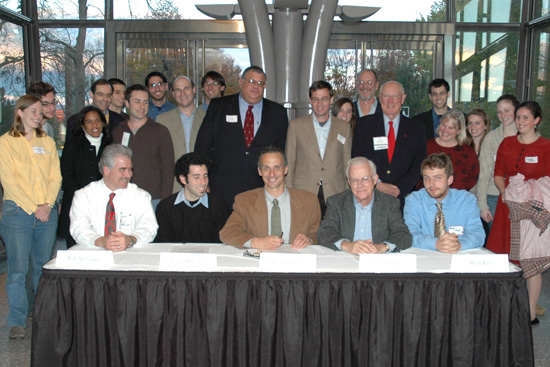Roth Signs President Climate Commitment
 |
| President Michael Roth, center, signed a document Nov. 16 stating that he and Wesleyan will support measures to fight global climate change. Pictured left to right are Bill Nelligan, director of Environmental Health, Safety and Sustainability; Jacob Mirsky ’08, representative of EON; Roth; Jim Dresser, chair of the Wesleyan Board of Trustees; Matthew Ball ’08, member of the Wesleyan Student Assembly. |
| Posted 11/20/07 |
| President Michael Roth signed the American College and University Presidents Climate Commitment before an applauding crowd of several dozen Wesleyan students, staff, faculty and trustees on Nov. 16.
The commitment can be seen in full text here. It has been signed by 434 other college and university presidents to date. The impetus to sign the agreement was in part a result of efforts by the Wesleyan environmentalist organization known as EON (Environmental Organizers Group). Wesleyans student assembly also passed a measure in support of Roth signing the document. We hoped that president Roth would listen to our plea, said Jacob Mirsky 08, an EON member who spoke at the signing. By signing the commitment, President Roth is ensuring Wesleyans institutional dedication to fight global climate change. EON and others on campus raised awareness about the commitment in September. After discussing the initiative with members of his administration, Roth decided to add his signature, and Wesleyans commitment, to the pledge. I think its really important to make an institutional commitment to improve our behavior as we deal with this crisis of climate change, Roth said. We cant cure the ills of the world, but we can take steps to do what we can to make the world a better place. Roth pointed out that Wesleyans commitment to green initiatives has been longstanding and expansive. A few of these measures include: — Between 2002 and 2006, Wesleyan reduced electrical power consumption, which constitutes the greatest annual variable cost incurred by the university, from 4.5 megawatts to 3.5 megawatts. This was done through conservation measures, load shedding and power plant management, and achieved while new buildings were being opened for use. Conservation efforts alone produced a 4.5 percent electrical consumption reduction between 2005 and 2006. — The recent 270 bed Fauver Residence was designed and built to be one of the most energy-efficient facilities of its kind. In 2005, the residence was awarded with Leadership in Energy and Environmental Design Certification (LEED). LEED is an independently developed standard for environmentally-friendly design and construction. — The university has completed 29 energy management projects in the last three years that have an average return on investment of 1.8 years and have produced annual energy savings of more than $275,000. — The university plans to install a cogeneration system, also known as CoGen. CoGen is the use of a single fuel source to simultaneously generate both electricity and heat. The CoGen system would be integrated with Wesleyans existing facilities. It will cost approximately $1.7 million after a $1.3 million rebate from the Connecticut Department of Public Utility. The facility will save about $500,000 a year in energy costs. In addition, Wesleyan has undertaken dozens of smaller scale measures to improve environmental efficiency and expand green practices, all of which cumulatively are producing visible results. In addition, the university has undertaken extensive recycling efforts. To continue to do these things this will not be easy, Roth said. It will cost us some money and we will have to rethink some plans. But it is a commitment we all feel strongly about. We are creating momentum for change. Summaries of Wesleyan’s sustainability initiatives can be found online at: |
| By David Pesci, director of Media Relations |

